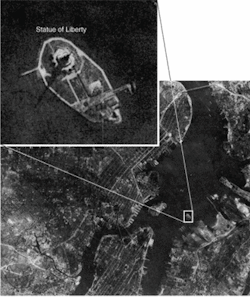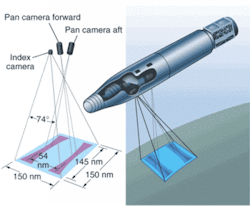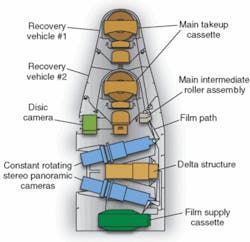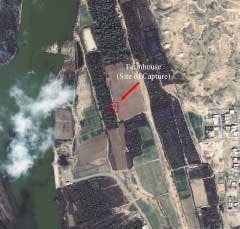While the newest generation of optical surveillance satellites provides superior resolution, it still has limitations. Plans are under way for improvements in resolution, speed of information, and the ability to track missiles.
Spy satellites were America's hidden agenda at the dawn of the space age. Optical surveillance satellites profoundly affected the course of the Cold War, but they officially remained under deep cover until President Jimmy Carter announced their existence in 1978. Not until 1992 did the U.S. government even admit the existence of the National Reconnaissance Office (NRO), which managed the program.
The Cold War is now a memory, but optical surveillance satellites continue to play a vital role in national security. Satellite imaging technology has spread to Earth-resources satellites such as LANDSAT and commercial imaging satellites such as Ikonos. The exact capabilities and technical details of today's surveillance satellites remain classified, but early programs have been declassified and the basic capabilities of current systems can be deduced and described.
Corona: The first spy satellite
The attack on Pearl Harbor taught American intelligence officials the importance of tracking the actions of potential adversaries. The Cold War reinforced the lesson when the Soviet Union surprised Americans with tests of its first atomic and hydrogen bombs. The United States responded by developing the high-altitude U-2 spy plane, and investigating prospects for surveillance satellites.
RAND Corporation studies led the U.S. Air Force to launch a program in late 1956 to develop a reconnaissance satellite known as WS (Weapon System) 117L. This technically ambitious program envisioned recording images in space and transmitting the data to the ground for analysis. In 1957, realizing that it would take time to develop those advanced capabilities, a small RAND group suggested a simpler interim approach: recording images on film, and returning a canister of exposed film to the ground. That soon became a small part of the WS 117L program.
Meanwhile, the Soviets raised the nuclear stakes by testing an intercontinental ballistic missile in August 1957, and launching the first artificial satellite, Sputnik I, on Oct. 4, 1957. The two launches showed there wasn't time to wait for an ideal satellite. In February 1958, President Dwight Eisenhower approved a crash program to develop a film-return satellite to fill the intelligence gap until the WS 117L was ready. Code-named Corona (from an office typewriter), it was run jointly by the Air Force and the Central Intelligence Agency, an arrangement similar to the development of the U-2.
Reconnaissance cameras were available for aircraft use, but spacecraft posed new problems. Designers at Itek —newly spun off from the Boston University Optical Research Laboratory—proposed a panoramic ƒ/5 camera with 24-in. focal length, similar to designs used for photographing large groups of people. The film remained stationary while the optics rotated, imaging an area 10 × 120 miles on the ground onto a strip of film about 2.2 in. wide and 30 in. long. Then the film was moved to take the next shot. The design was entirely mechanical, with diffraction-limited optics that held out the potential for beating the original goal of 25-ft resolution on the ground.
Concealed under the guise of an engineering test and biomedical research program called "Discoverer," the project got off to a rocky start. Troubles ranged from uncooperative research animals to film handling, but the biggest problems were related to the booster and final stage. Not until the 13th launch in August 1960 did Corona successfully return a capsule—but it contained only an American flag, which was presented to President Eisenhower. The next launch a week later carried a camera, and its capsule delivered 20 pounds of film that showed that Soviet missile programs were not as advanced as had been feared. More successes followed, revealing Soviet military sites and mapping them so American missiles could target them (see Fig. 1).
Corona's success left the WS 117L program in the dust, and it was ultimately dropped. A series of updates kept the Corona cameras and film-recovery system going until 1972. The initial acetate film proved unsuitable for use in space, so it was replaced with a polyester-based film. Resolution of the optics and the film were improved, and a stereo camera was developed to aid in interpretation (see Fig. 2 and 3). The ground resolution improved from 40 ft for the original camera to 6 ft for the final version.
FIGURE 3. Inside the KH-4B Corona satellite, the rotating panoramic cameras recorded stereo pairs for image analysis; the DISIC camera took lower-resolution images for calibration. The two recovery vehicles were returned to the ground separately. (Based on NRO drawing).
The existence of spy satellites became an open secret after President Lyndon Johnson mentioned them "off the record" in 1967, but officially their existence was classified until Carter's 1978 announcement. By then, NRO had replaced Corona with a bigger and better generation of spy satellites, and the Pentagon had deployed its own family of early-warning IR satellites. Corona images remained classified until 1995.
Later programs
The first step beyond Corona was a family of upgraded film-return satellites called the KH-7 and KH-8 Gambit, with resolution of the later KH-8 version reportedly as fine as 3 in. The first launches came in the mid-1960s, and the final three launches were in the 1980s. Their big advantage was their high resolution, but they couldn't cover as much territory as Corona, which remained in use until 1972. Yet film-recovery satellites could not deliver the real-time data that intelligence agencies and the Air Force wanted to monitor activities of potential adversaries and give early warning of possible missile attacks. That led to development of two families of massive but lower-resolution satellites: low-orbit versions for reconnaissance, and high-orbit versions for early warning.
The NRO developed the KH-11 Kennan low-altitude satellite; upgraded versions, still called KH-11, are still in use. First launched in 1976, the KH-11 is a reflective telescope in a long cylindrical tube, which images the ground onto a CCD detector array. The Hubble Space Telescope borrowed from the KH-11 design to take advantage of existing fabrication capabilities. The designs differ greatly however, reflecting the differences in tracking and focusing on astronomical objects rather than the Earth's surface. Early KH-11s observed at visible wavelengths in the daytime, but later versions added IR sensors for night observation. It's a safe bet that the imaging arrays are the highest resolution versions that money can buy. The satellites orbit at 250 to 550 miles, transmitting data to the ground in real time via military relay satellites, with highest resolution said to be 6 in. (15 cm).
The Air Force launched its first Defense Support Program (DSP) satellite in 1970, and upgraded versions are still in service. Equipped with IR sensors and radiation monitors, they look for signs of nuclear explosions or rocket launches from a geosynchronous orbit. Their IR sensors also can spot aircraft crashes, pipeline fires, and explosions. Their high elevation limits the resolution, but they transmit data to the ground in real time. Like the NRO satellites, DSP satellites are large and include propellants for maneuvering.
FIGURE 4. Images at 1-m resolution from Ikonos taken in February of last year spotted the farmhouse northwest of Ad-Dawr, Iraq, where Saddam Hussein was captured Dec. 13. The building is in a grove of trees and approximately 270 m from the Tigris River. (Other examples of Ikonos images are on the web at www.spaceimaging.com).
The Soviet Union developed surveillance satellites with similar capabilities. Both countries also deployed spy satellites that operated in other parts of the spectrum for eavesdropping and making radar observations. Civilian satellites also developed similar capabilities—but with lower resolution—to collect Earth-resources and mapping data, observe weather conditions, and record images for other applications. Color images from the Ikonos satellite with 1-m resolution can be purchased that show cars and trucks on the ground (see Fig. 4).
Technical capabilities
Precise data on spy-satellite performance is classified, but it is possible to make reasonable estimates from information in the public domain. The Hubble mirror is 2.4 m in diameter. Spy satellites are bigger, but their mirrors can't be wider than the rocket launching them unless they can be unfolded in space, a capability only now being developed. That limits them to mirrors of about 5-m diameter. Assuming that the mirror is optically perfect, we can calculate the Airy diffraction limit for a mirror with diameter D of 5 m observing at a nominal visible wavelength l of 0.5 µm as:
null
That gives an angle of 0.122 µrad, which allows a resolution of 2 cm if the satellite dips to an elevation of 150 km, but long-term operation requires a higher orbit. Current KH-11 satellites orbit at 250 to 550 miles (400 to 900 km), which at the lower elevation gives a diffraction-limited resolution of 5 cm (2 in.). That's three times better than the quoted 6 in., but far from the rumored ability to "read the numbers on a license plate."
Actual resolution is limited by atmospheric turbulence, well known for its degradation of astronomical seeing. The good news for spy satellites is that turbulence close to the object and far from the camera isn't as disruptive as turbulence close to the telescope. That's a good thing, because adaptive optics don't work as well for large-area images as they do for small astronomical objects.
Also, practical resolution is limited by the sensors and tradeoffs with coverage area. If the smallest resolution element is 5 cm, a detector array 10,000 elements wide would record a stripe only 500 m wide. That would be acceptable for a high-value target, but not for routine imaging.
Another practical consideration is translating theoretical resolution to the interpretation of images by highly trained specialists. The Airy limit is an ideal for sharply distinguished objects, but real objects can appear similar to the eye of the interpreter because of color or viewing angle. The popular idea of spy satellites reading license plates is a good example of something that won't work because license plates are mounted vertically on the fronts and backs of cars, where overhead satellites can't see them clearly. Likewise, orientation makes it easier for satellites to see details on roofs than on walls.
Building a new generation
Looking back, the current generation of spy satellites has done its job remarkably well. Some early designs didn't work, and most had the traditional teething problems of cutting-edge space projects—particularly launch failures. But none of the mistakes were as publicly humiliating as the error that left Hubble's primary mirror figured perfectly to the wrong shape. Like Hubble, Corona and its successors proved invaluable once they were up and running, giving the U.S. vital insight into Soviet missile programs, and helping to defuse dangerous tensions.
Tomorrow's systems are intended to provide new capabilities needed to meet a new set of goals. The Air Force's Space Based Infrared System (SBIRS) is supposed to identify missile launches as well as track missiles and guide missile-defense systems to destroy them. The NRO's Future Imagery Architecture is intended to replace the three current KH-11 satellites with a larger fleet of smaller satellites to provide more information faster in all types of weather, giving field commanders quick updates on battlefield conditions.
Both programs are extremely ambitious and have been in the works for years. Both are running over budget and behind schedule, but this time the government has no backup program like Corona in the queue to come to the rescue. Military and security agencies may be forced to turn to commercial services like Ikonos and a planned successor with resolution of 25 cm that the government has already licensed.
Bibliography
Eric J. Chaisson, The Hubble Wars (Harper Collins, New York, 1994).
Dwayne A. Day, John M. Logsdon, and Brian Latell, Eye in the Sky: The Story of the Corona Spy Satellites (Smithsonian Institution Press, Washington, 1998).




